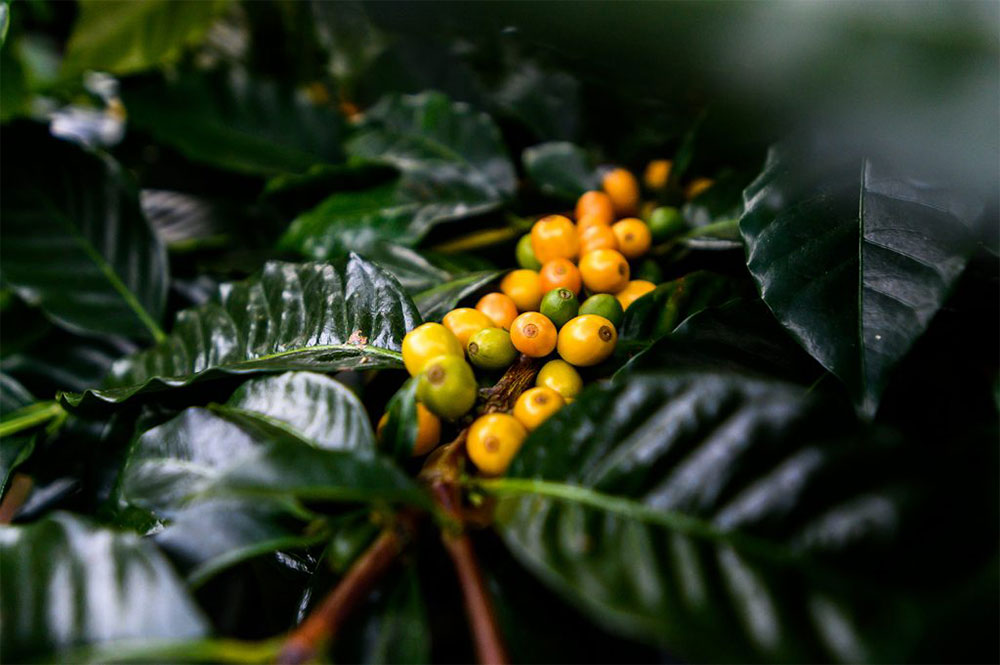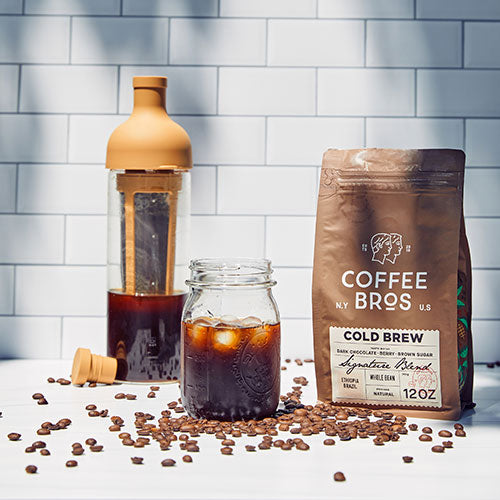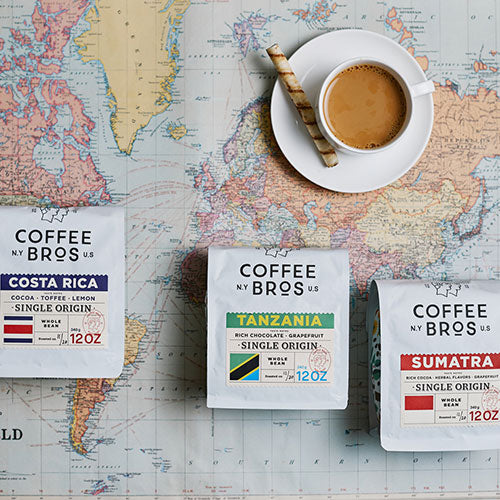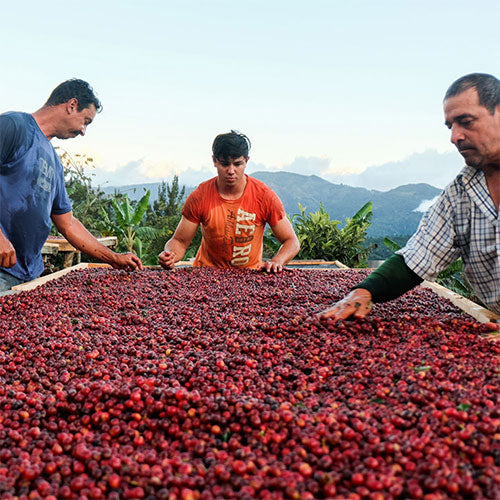Specialty coffee: a multipurpose term that defines an industry
Introduction
Specialty coffee has become a term representing more than the difference between commodity-grade coffee and higher-end lots. In our view, specialty coffee has become a movement that inspires change in the sector to not only push the boundaries of taste and quality but to display the uniqueness of coffee, everything from producer value, growing conditions, processing methods, varietals, roasting process, and even down to what brewing equipment works best for a specific coffee.
While specialty coffee as a term still represents cup quality, the term has spun into something far beyond the simple definition of a cupping score. Specialty coffee has become a behemoth of an industry where technology, equality, and sustainability have become the driving force behind much of what we see. From technology-driven new brewing products (like the xBloom and Decent espresso machines) and roasting advances to an industry-wide push from both internal representatives and consumers seeking change and transparency around producer-led issues (pay, health, sustainability), environmental concerns, and even the health and genetics of the coffee specie.
As roasters, we strive to be a part of specialty coffee every day, from sourcing the highest-quality coffee possible to establishing long-term direct and sustainable partnerships with producers. We actively give back to the coffee community in hopes that we are participating in positive change to help further the specialty coffee industry.
Below, we’ll break down what specialty coffee means both historically, its widely accepted term usage as far as grading, and a bit of an opinion on what we think specialty coffee means now.
Table of Contents
- The origins of Specialty Coffee
- Specialty Coffee as a coffee-grading classification
- Specialty Coffee from farm to roaster
-
What does Specialty Coffee mean now
- Specialty Coffee and the consumer
-
Organizations that help further Specialty Coffee
- Cup of Excellence
- World Coffee Research
- Grounds for Health
- Specialty Coffee Association
The origins of specialty coffee
Specialty coffee is not a new trend and has existed in various forms since the early 1900s, with discerning customers like the Hotel du Crillon in Paris specifying coffee from select micro-lots on specific farms in certain regions of Guatemala. The term "specialty coffee" was coined by Erna Knutsen in 1974, and the Specialty Coffee Association of America was established in 1982.
Specialty coffee, when concerning grading, is defined as coffee that is free of primary defects, has no quakers, is uniformly sized and dried, presents in the cup free of faults and taints and has distinctive attributes, and must score 80 or higher out of 100 on a standardized score sheet by a panel of expert coffee tasters known as Q Graders.
Only around 10% of all coffee produced reaches specialty grade. Thanks to agricultural, roasting, and brewing technology improvements and increased demand for high-quality coffee, specialty coffee is now widely available to coffee lovers worldwide.
In 1999, the Cup of Excellence educational programs were launched for producers, and prestigious and rigorous competition and auction helped push and define specialty coffee worldwide. The competition and auction displayed the highest quality coffees by country and region, and educational programs gave the tools and resources to producers to help them improve their coffee and the economic model of their farms.
To better comprehend what specialty coffee is today, it is essential to consider how the industry evolved through a grading system and how the pursuit of superior quality drove its development.
Specialty coffee: the grading of coffee
| Score | Quality | Classification |
|
90 - 100 |
Outstanding |
Specialty |
|
85 - 89.99 |
Excellent |
Specialty |
|
80 - 84.99 |
Very Good |
Specialty |
|
< 80.00 |
Below Specialty |
Not Specialty |
Specialty coffee is defined as coffee that scored 80 or above out of 100 on a standardized score sheet evaluated by a panel of expert coffee tasters known as Q Graders. On the other hand, coffee that scores below 80 is classified as commodity-grade coffee.
The coffee-grading definitions of both commodity-grade and specialty coffee are as follows:
Commodity Grade Coffee: Commodity-grade coffee is defined as being interchangeable with another coffee of the same type. Easily interchangeable coffee often means that flavor attributes lean toward the neutral to the negative side.
Specialty Coffee: The SCA defines Specialty Coffees as those with positive flavor attributes, minimal defects, and one assigned a score of 80+ (on a 100pt scale). Specialty coffee starts at the source with optimal growing and post-harvest processing. The care continues as the coffee leaves the country of origin and often is protected in hermetically sealed packaging that helps lock in freshness. At Coffee Bros., we focus on sourcing high-end (86pt+ coffees), great-tasting coffee from all our blends to our single-origin and award-winning lots.
We, as roasters, have certainly seen this scale shift higher over the years. Many who consider themselves specialty coffee roasters are most likely homing in on coffees at or above 84pts and above and not taking on any coffee in the 80pt range. While this creates its own set of problems from a sustainability aspect, it is undoubtedly noticeable within the industry. The slide in the scale toward higher points is undoubtedly due to the sophistication of specialty coffee as an industry that has gone through since the introduction of the definition. Both professionals and consumers continue to demand higher-grade coffee, and the push toward better harvesting techniques, processing, post-processing, and roasting techniques is helping to make that wish come true.
What is a coffee Q grader
Q Graders are professionally trained and certified individuals in the sensory evaluation of green coffee. This certification is recognized worldwide in the coffee industry and is highly valued by employers in various roles, including quality control personnel, roasters, green buyers, and exporters.
Q Graders have a common understanding of quality coffee and use this shared language to communicate and access markets. With a Q Grader certification, individuals in the coffee industry have expanded opportunities due to the recognition of their skills in product quality evaluation, flavor analysis, and consistency assessment.
While Q Graders define and grade a coffee on a 100pt scale, it must be noted that there are many ways to cup and score a coffee, from the SCA standards and individual importer preferences to the Cup of Excellence scoring methodology. Further, cupping coffee for flavor can be highly objective, especially when only one individual is behind the cupping before it gets graded and sent off to the country of import. There is no official record of all cupping scores leaving a particular country or region.
While the above may sound like coffee grading is highly objective, there is a science behind the process, and the score is not solely flavor driven. Furthermore, once the coffee reaches its intended final destination, either with an importer or roastery, it often goes through several additional evaluations and scoring before being released to the market.
How is coffee graded
We’ve left out a good portion of what is being scored when evaluating a coffee for overall quality, but the below evaluation sheet will show you some of what is considered.
Specialty Coffee from Farm to Roaster
Specialty coffee varietals
Costa Rica 95
Pacamara
Typica
Gesha
SL28
Specialty coffee harvesting
After gaining insight into how certain coffee varieties typically score higher than others, it's apparent that well-maintained and harvested plants are crucial in the coffee journey from farm to evaluation to your cup.
The harvesting method becomes paramount when assuming the right terroir, planting techniques, weather conditions, and plant health are observed. Coffee beans come from the seeds of the coffee fruit, commonly referred to as "cherries" because they resemble cherry fruit. Specialty-grade coffees are typically handpicked, selecting only ripe coffee cherries while discarding overripe fruit and allowing immature ones to mature. This selective process is necessary because coffee cherries don't ripen simultaneously. Conversely, commodity coffees use mechanical stripping to collect the entire plant once most of the coffee is ripe. This practice results in a mix of cherries at different stages of maturity, leading to inconsistent flavors.
After the harvest is complete and consistent, the processing method, such as natural, washed, honey, anaerobic, or anything in between, becomes the next most significant factor impacting coffee grades and cupping scores.
Specialty coffee processing
While producers may not have been lucky enough to land a varietal that tends to score highly, the following processing step can influence the coffee’s quality, and taste, and ultimately score to land it within the specialty range.
The process of the coffee (Natural, Washed, Honeyed, etc.) loosely defines how the coffee was processed post-harvest. The post-harvest process has a great deal of impact on potential taste attributes and the quality of the finished product. While great-tasting coffee has come from every type of process, you will learn that specific processes may have flavor profiles more in line with your palette.
Here are some examples of processing methods:
Anaerobic Fermentation
Anaerobic fermentation is a process gaining popularity in the coffee industry where coffee is fermented in a low-oxygen environment for a certain period of time. The coffee is loaded into a sealed container which creates a low-oxygen environment and allows certain microbial species to thrive and contribute to the flavor profile of the coffee. However, it's important to note that the term "anaerobic" only refers to one step in the coffee's processing and does not give the complete picture of the coffee's post-harvest treatment. Different farms and countries have varying methods of anaerobic fermentation, and the process could include additional steps such as koji fermentation or being fermented again in an open-air tank. It's more accurate to use terms like "an anaerobic step for X duration of time" or "fermented in an anaerobic environment for X period of time."
Decaffeination
Decaffeination is a process used to remove caffeine from coffee beans. There are several methods for decaffeination, including the use of solvents (such as methylene chloride or ethyl acetate), carbon dioxide, and water.
Honey Process
The honey processing method for coffee involves removing the cherry but retaining the sticky mucilage layer. This layer imparts flavor to the coffee and results in a heavier body, sweet fruitiness, and moderate acidity. There are three variations of the honey process: Yellow Honey, Red Honey, and Black Honey, which differ in the frequency of turning the coffee during drying. On average, the drying time is 18 to 25 days and the result is a coffee that has a lower acidity and a sweetness reminiscent of caramel or burnt sugar.
Natural Decaffeination
The process works by soaking green coffee in a solution of E.A., which bonds to the salts of chlorogenic acid in the coffee and allows for the removal of caffeine. The coffee is removed from the solvent and steamed at low pressure to remove the E.A. compounds, and the finished product retains its flavor integrity but contains almost no caffeine at all. (The beans will contain a maximum of 0.01–0.03% caffeine.)
Natural Process
The natural process of coffee preparation involves picking the coffee cherries when they are ripe and allowing them to dry around the seed before removing the fruit. This method is different from the washed process where the fruit is removed quickly after harvesting. The natural process is mostly used in Ethiopia, Yemen, Brazil, and Costa Rica, but is also being experimented with by coffee producers around the world. The fermentation process of the coffee starts from the moment it is picked and can continue until it reaches a moisture level of 11%. This process can be influenced by temperature, exposure to sun or shade, depth on the drying bed, and rotation during drying. The natural process takes longer and is riskier than the washed process as it requires more space, attention, and labor to prevent mold and infestation during drying. The natural process is the oldest method of coffee preparation and in some cultures, the coffee fruit was allowed to dry completely on the branch. Modern natural coffees are harvested ripe and dried intentionally, typically on patios, raised beds, or drying tables, and cannot be dried in mechanical dryers like washed coffees.
Swiss Water Decaffeination
One of the most common methods is the Swiss water method, which uses only water to remove caffeine. In this method, the coffee beans are soaked in water, which dissolves the caffeine and other soluble substances. The water is then passed through a carbon filter that removes the caffeine, while the other soluble substances are left behind in the water. The coffee beans are then re-soaked in the same water, which restores the soluble substances to the beans while removing the remaining caffeine.
Washed Process
Washed or Wet process is considered the quickest and most efficient post-harvest processing method and is commonly used to prepare specialty-quality coffee in most of Africa, Central and South America (except Brazil), and some parts of the Asia-Pacific region. The term "Washed" usually refers to the process of removing the coffee fruit from the seed as cleanly and quickly as possible. However, there are different interpretations of "Washed" coffee, such as "Fully Washed" which uses water and others that have their mucilage mechanically removed.
Many of the highest-scoring coffees in recent Cup of Excellence auctions are processed using anaerobic fermentation (dry fermentation), a technique taken from the wine industry. Coffee producers leverage this technique to impart a unique flavor and aromatics.
Specialty coffee roasting
The coffee has been cared for, harvested, processed, and graded multiple times and landed at a coffee roasting facility. Coffee roasting has advanced over the years thanks to roast tracking software like Cropster to the influence of methodologies and techniques from those in the industry like Scott Rao, Rob Hoos, and others who have helped to advance the industry.
Specialty coffee roasters have more technology and science behind them than they did even 10 years ago. The tracking software to help analyze and record your coffee roasting process has been revolutionary in allowing specialty coffee roasters to improve consistency and home in on what aspects of roasting positively impact taste. Furthermore, advances in coffee roasting machines have also improved consistency, making the cup of coffee you drink today far superior or at least more consistent week to week than in the past.
We define specialty coffee roasters as those who leverage current and accepted techniques and technology to help improve their product's consistency and cup quality. Technology here doesn’t mean these roasters leverage the latest and greatest machines. A vintage 1960s Probat can be equipped with sensors to display analytical software to improve coffee quality and consistency as easily as an out-of-the-box new roaster can.
What does specialty coffee mean now
Specialty coffee, although still primarily associated with cup quality, has evolved into a massive industry beyond the basic definition of a cupping score. Nowadays, technology, fairness, and sustainability are major driving forces in the industry. There have been advancements in brewing equipment, such as the xBloom and Decent espresso machines, and roasting techniques. Moreover, the industry is shifting significantly as internal members and consumers demand greater transparency regarding producer-led issues, like pay, health, and sustainability. Environmental concerns and the coffee species' genetic makeup are also important topics.
If you have heard of the terms “first wave,” second wave,” and “third wave” coffee, these were the interpretations of where coffee as an industry is in its current state. Some have stopped the term “third wave.” In contrast, others believe we are in the “fourth wave” of coffee. We like to define what is happening in the industry as an extension of the “third wave” of coffee, as that is the stage that brought specialty coffee to the world. Regardless of the wave, specialty coffee is the constant iteration of the industry that focuses on quality, consistency, sustainability, technology, and the constant improvement of the livelihoods of all those involved. We see specialty coffee, again, as more than a simple (or not so simple if you looked at the cupping form) grading terminology and more of a living and breathing ecosystem that is constantly trying to evolve for the better.
The rise of the home barista
The specialty coffee industry has seen a recent rise in Gen Z's coffee preferences and growth in at-home specialty coffee drinks. Creative drinks, bottom-up innovation, and a fresh approach to coffee marketing have pushed specialty coffee products and equipment to the forefront. Home-made premium coffee drinks made with upgraded home coffee machines have also contributed to the desire for more high-grade specialty coffee.
Home baristas are becoming more skilled and sophisticated, focusing on better grinding, espresso preparation, and high-quality water. The desire for more advanced at-home equipment has sprung up innovative coffee equipment from grinders to brewers from legacy coffee companies to upstart Kickstarter-funded companies. The move toward highly sophisticated equipment that comes close to, or matching café quality has been a focus within the specialty coffee industry for the last 5 years.
Coffee media: YouTube and TikTok
The surge in popularity of specialty coffee and the emergence of skilled home baristas can be attributed in part to the proliferation of educational resources and a novel approach to coffee making on social media platforms such as YouTube, Instagram, and TikTok. Influential figures in the industry, such as James Hoffmann and Lance Hendrick, who possess extensive knowledge and experience, have utilized these platforms to educate others on proper brewing methods, review equipment, and share insights on coffee trends. This has accelerated the learning curve for aspiring home baristas, allowing them to improve their skills quickly and easily and desire more from the specialty coffee industry.
Organizations that help further Specialty coffee
Specialty coffee wouldn’t be what it is today without many organizations shaping the industry. From progressive and needed initiatives to help further the livelihoods of producers, to cutting-edge research to help preserve and advance the coffee species.
Here are some of the organizations that are helping define what specialty coffee is and will be.
Cup of Excellence
The Cup of Excellence was founded in 1999 as a global project to help producers receive more money and recognition for their high-quality coffees. The Cup of Excellence is a rigorous competition that is region-based and has both National and International juries.
The Cup of Excellence is a multi-faceted organization that holds competitions and auctions worldwide while also providing coffee producers with the tools, training, and education they need to improve their products.
Each country sees hundreds of entries into their Cup of Excellence competition, where the top 30 move on to the final auction. Those that make it to the auction see long-term impacts on their livelihood due to greater profits and exposure to their farm.
The greater profits often garnered from the auction can lead producers toward further investing in their equipment and people. The name recognition sticks, and with the Cup of Excellence farmer directory being public, this generally leads to new business.
SCA
The Specialty Coffee Association (SCA) is a global trade organization that aims to make coffee a sustainable, equitable, and thriving industry for all members of the value chain. From coffee farmers to roasters and baristas, the SCA acts as a unifying force within the specialty coffee industry, raising standards worldwide through a collaborative and progressive approach. The SCA is dedicated to building an industry that is fair, sustainable, and nurturing for all. The organization has six core values including relevant member value, the sustainable coffee industry, a community of communities, best people, ethical operation, and respect for the individual. The SCA's mission is to engage, inspire, and expand the global specialty coffee community through leadership in events, education, and research.
World Coffee Research
World Coffee Research is a non-profit organization (501(c)(5)) that collaborates with the global coffee industry to improve the quality of coffee and improve the livelihoods of coffee producers. Its mission is to increase, preserve, and enhance the quality of coffee while improving the livelihood of those who grow it.
Grounds for Health
Women are the backbone of the coffee workforce, especially at origin where they provide 70% of the labor planting, picking, sorting, and processing the coffee beans. Cervical cancer is the #1 cause of cancer death in Latin America, Sub-Saharan Africa, and Asia, where coffee is grown; and, it is entirely preventable with early screening and treatment. Grounds for Health is an international non-profit organization with a mission to prevent cervical cancer in coffee communities. We work within the public health system to develop a sustainable, comprehensive program to keep women healthy and stop deaths from this entirely preventable disease.




